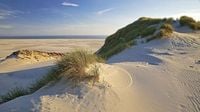On Monday, April 21, 2025, a dramatic rescue operation unfolded off the coast of Amrum, where 25 people, including four children, were saved from the mudflats of the North Sea. The group, comprised of 32 Wattwanderers, was attempting to traverse the challenging terrain from Föhr to Amrum when they encountered an unexpectedly strong current that left them stranded on a sandbank.
The incident began when the group, led by experienced Nationalparkwattführer Dark Blome, found themselves unable to navigate a Priel—a water channel in the mudflats—due to rising tides. "There was a hole that was 40 centimeters deep," Blome recounted. After a member of the group fell into the hole, he followed to assist her, resulting in both of them getting water in their Wathosen (wading trousers). "In that moment, as the woman sank and I followed—feeling the current—I thought, 'That's it. We won't make it through,'" he told NDR Schleswig-Holstein.
While eight members of the group managed to reach Amrum on their own, Blome and the remaining 24 were left on a sandbank, approximately 300 meters from the Amrumer Odde, the northern tip of the island. With the air temperature at 11 degrees Celsius and the water temperature at 9 degrees Celsius, the situation was becoming increasingly precarious.
Recognizing the danger, Blome made the wise decision to call the Deutsche Gesellschaft zur Rettung Schiffbrüchiger (DGzRS), the German Society for the Rescue of Shipwrecked Persons. "I would never have had a chance to get everyone through," he admitted. "I was soaked and freezing. A little boy was really scared."
The DGzRS quickly dispatched the rescue cruiser "Ernst Meier-Hedde," which launched its daughter boat, the "Lotte," designed to navigate shallow waters with a draft of only 80 centimeters. "My colleague and I headed towards the scene," Thomas Berndt of the DGzRS recounted. "We couldn't get all the way there and had to walk through the water. Then my colleague secured a line to the stranded individuals, creating a safe connection with our ship."
Thanks to their efforts, the rescuers managed to transport the stranded Wattwanderers back to safety in two trips. Most of the group remained calm throughout the ordeal, although Berndt noted that some exhibited signs of fear. Fortunately, aside from minor hypothermia, all were unharmed.
Blome, who has been leading tours through the mudflats for 29 years, expressed disbelief at the unexpected conditions. "I don't know where the water came from," he said. "We had a water level at high tide of minus 20 centimeters, so there was hardly any water. The low tide was reported at plus 30 centimeters. I had told all guests that they would be up to their belts in water. Just two days ago, I crossed here with a group without any issues."
The DGzRS emphasized that Blome acted wisely and appropriately in contacting them, as the situation could have escalated if the group had attempted to continue. "The water would have continued to rise. In these areas, there is a significant current. Panic or fear reactions could have occurred," Berndt warned, highlighting the unpredictable nature of the North Sea.
Interestingly, as the rescued group reached Amrum, they were met with onlookers filming the scene. Blome expressed disappointment at this behavior, stating, "I found it unfortunate to film people disembarking from a ship in fear." Despite this unsettling experience, he remains committed to his work. He is scheduled to lead another tour from Amrum to Föhr on Friday morning, April 25, 2025, and is hopeful that such a situation will not arise again.
The DGzRS also issued a reminder to the public regarding safety in the mudflats. They urged individuals never to venture out alone, as the power of the tides and the nature of the seabed pose significant risks. They advised that people should always go in groups, accompanied by a guide, and to be mindful of the tides, allowing ample time for the return journey.
Essential safety tips include marking a landmark on the mainland, avoiding areas near Prielen during rising water due to strong currents, and only embarking on mudflat hikes during daylight hours in good weather. Proper clothing is also crucial, including headgear, sunscreen, and windproof jackets. In case of fog, walkers should follow their footprints back to the coast and call for help loudly and clearly.
This rescue operation serves as a vital reminder of the unpredictable nature of the North Sea and the importance of preparedness and caution when exploring its unique landscapes.




